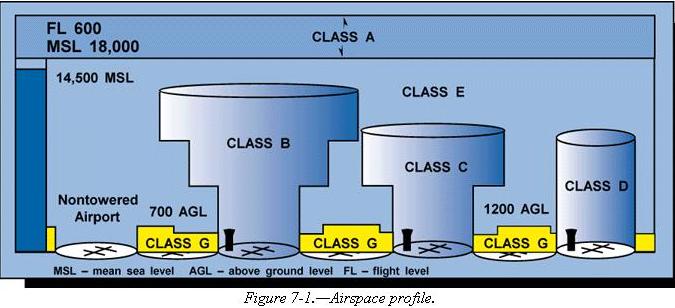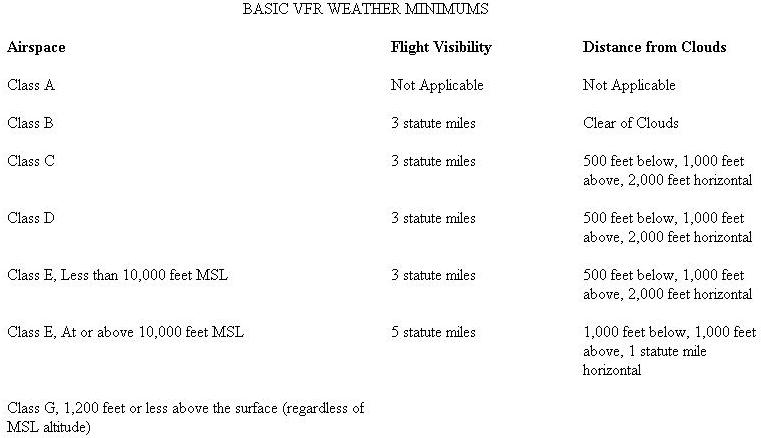
INTRODUCTION
This chapter introduces the various classifications of airspace and provides information on the requirements to operate in such airspace. Further information can be found in the Aeronautical Information Manual.
The two categories of airspace are: regulatory and nonregulatory. Within these two categories there are four types: controlled, uncontrolled, special use, and other airspace.
Figure 7-1 presents a profile view of the dimensions of various classes of airspace. Figure 7-2 gives the basic weather minimums for operating in the different classes of airspace. Figure 7-3 lists the operational and equipment requirements. It will be helpful to refer to these figures as this chapter is studied. Also there are excerpts from sectional charts in Chapter 8, Navigation, that will show how airspace is depicted.
CONTROLLED AIRSPACE
Controlled airspace is a generic term that covers the different
classifications of airspace and defined dimensions within which air traffic
control service is provided in accordance with the airspace classification.
Controlled airspace consists of:
• Class A
• Class B
• Class C
• Class D
• Class E
Class A Airspace
Class A airspace is generally the airspace from 18,000 feet mean sea level (MSL) up to and including FL600, including the airspace overlying the waters within 12 nautical miles (NM) of the coast of the 48 contiguous United States and Alaska. Unless otherwise authorized, all operation in Class A airspace will be conducted under instrument flight rules (IFR).
Class B Airspace
Class B airspace is generally the airspace from the surface to 10,000 feet MSL surrounding the nation’s busiest airports. The configuration of Class B airspace is individually tailored to the needs of a particular area and consists of a surface area and two or more layers. Some Class B airspace resembles an upside-down wedding cake. At least a private pilot certificate is required to operate in Class B airspace; however, there is an exception to this requirement. Student pilots or recreational pilots seeking private pilot certification may operate in the airspace and land at other than specified primary airports within the airspace if they have received training and had their logbook endorsed by a certified flight instructor in accordance with 14 CFR part 61.
Class C Airspace
Class C airspace generally extends from the surface to 4,000 feet above the airport elevation surrounding those airports having an operational control tower, that are serviced by a radar approach control, and with a certain number of IFR operations or passenger enplanements. This airspace is charted in feet MSL, and is generally of a 5 NM radius surface area that extends from the surface to 4,000 feet above the airport elevation, and a 10 NM radius area that extends from 1,200 feet to 4,000 feet above the airport elevation. There is also an outer area with a 20 NM radius which extends from the surface to 4,000 feet above the primary airport and this area may include one or more satellite airports.
Class D Airspace
Class D airspace generally extends from the surface to 2,500 feet above the airport elevation surrounding those airports that have an operational control tower. The configuration of Class D airspace will be tailored to meet the operational needs of the area.
Class E Airspace
Class E airspace is generally controlled airspace that is not
designated A, B, C, or D. Except for 18,000 feet MSL, Class E airspace
has no defined vertical limit, but rather it extends upward from either
the surface or a designated altitude to the overlying or adjacent controlled
airspace.
 |
Figure 7-2.—Visual flight rule weather minimums.
 |
 |
| Figure 7-3.—Requirements for airspace operations. |
 |